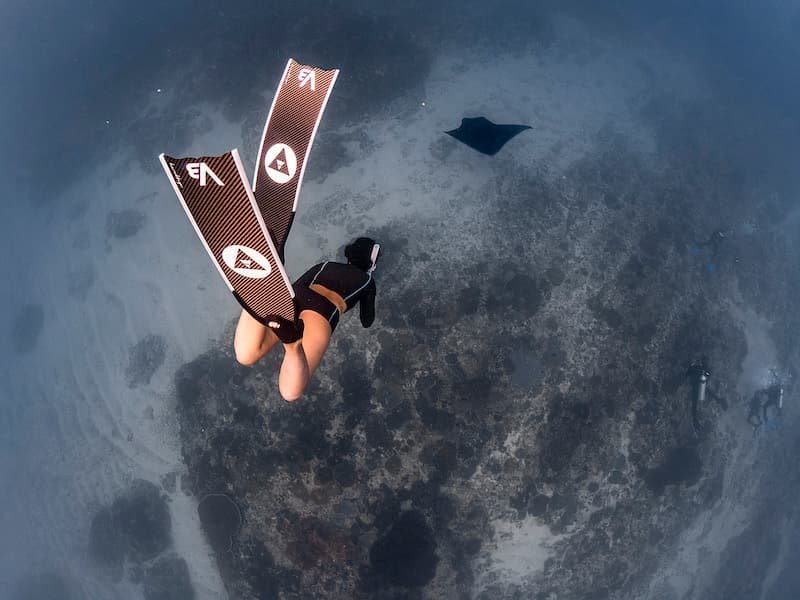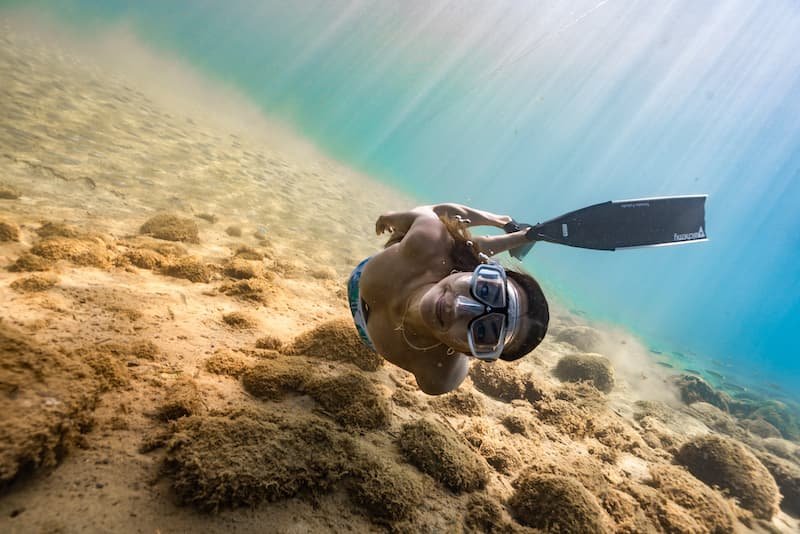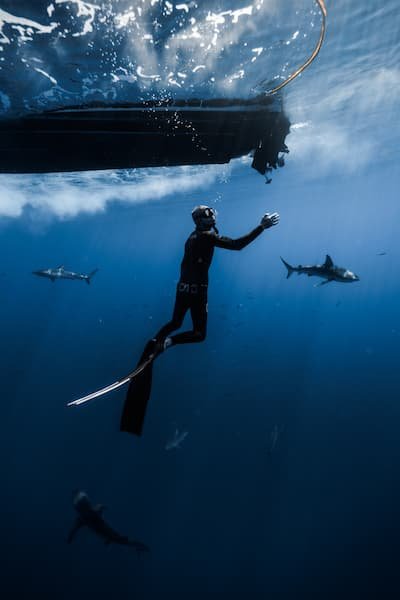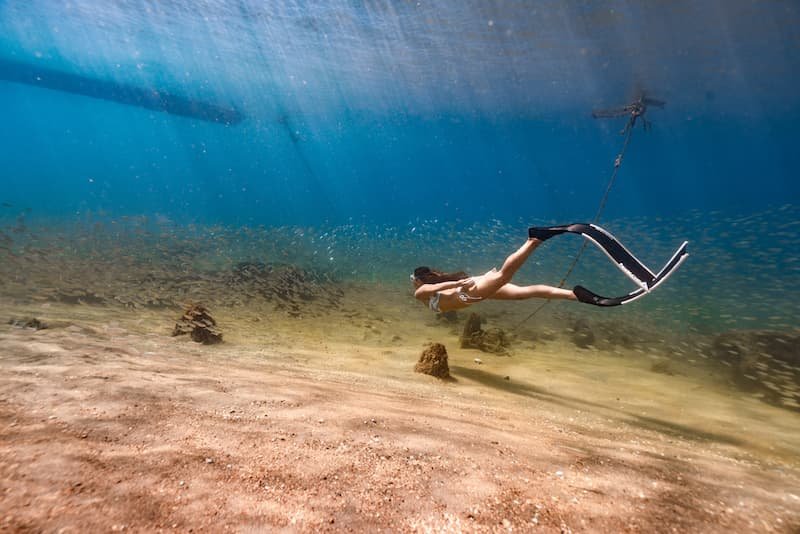
 Katie Wood
Freediver, Writer, Explorer
Katie Wood
Freediver, Writer, Explorer

 Katie Wood
Freediver, Writer, Explorer
Katie Wood
Freediver, Writer, Explorer
As the ocean's explorers, freedivers are intimately connected with the underwater world, forming a unique bond with marine environments. Yet, with increasing environmental threats, such as overfishing, pollution, and habitat destruction, the need for conservation efforts has never been more pressing. In this blog post, we look into the significance of marine protected areas (MPAs) and how freedivers can actively participate in and support conservation initiatives.
Marine Protected Areas (MPAs) are designated zones within the ocean where human activity is regulated to conserve marine life and habitats. These areas serve as sanctuaries for biodiversity, allowing ecosystems to thrive and recover from human-induced stressors. MPAs come in various forms, each tailored to specific conservation goals and management objectives.
One common type of MPA is the marine reserve, where all extractive activities, such as fishing and mining, are prohibited. These reserves act as underwater refuges, providing safe havens for marine species to reproduce, feed, and grow without the threat of exploitation. By safeguarding critical habitats such as coral reefs, seagrass beds, and mangrove forests, marine reserves play a vital role in maintaining ecosystem health and resilience.
Another form of MPA is the marine park, which allows for limited human activities while still prioritizing conservation objectives. Marine parks often feature zones with varying levels of protection, ranging from no-take areas to zones where sustainable fishing and recreational activities are permitted under specific regulations. This zoning approach allows for the sustainable use of marine resources while minimizing negative impacts on sensitive habitats and species.

No-take zones, also known as marine sanctuaries or marine protected areas with full protection, represent the strictest form of MPA. In these areas, all extractive activities, including fishing, mining, and collection, are prohibited to preserve biodiversity and ecosystem integrity fully. No-take zones serve as reference areas for scientists to study natural ecosystem dynamics and provide insights into the potential benefits of comprehensive conservation measures.
In addition to these primary forms of MPAs, there are other specialized designations, such as marine sanctuaries, marine monuments, and marine conservation areas, each tailored to address specific conservation needs and management priorities. Despite their differences in designation and management, all MPAs share a common goal: to protect and conserve marine biodiversity and habitats for present and future generations.

Research consistently demonstrates the effectiveness of MPAs in safeguarding marine biodiversity and ecosystem health. Numerous studies have shown that well-managed MPAs can lead to increased fish biomass, species diversity, and habitat resilience compared to adjacent unprotected areas. By providing refuge for marine species from human-induced threats such as overfishing, habitat destruction, and pollution, MPAs play a crucial role in maintaining ecosystem balance and function.
Furthermore, MPAs serve as vital breeding grounds and nurseries for marine species, contributing to the replenishment of surrounding areas and supporting fisheries outside their boundaries. The spillover effect, where adult fish and other marine organisms migrate from MPAs to adjacent areas, can enhance fish stocks and ecosystem productivity in nearby fishing grounds, benefiting both marine conservation and sustainable fisheries management.
Moreover, MPAs provide valuable ecosystem services such as coastal protection, carbon sequestration, and ecotourism opportunities, which contribute to local economies and livelihoods. By preserving healthy marine ecosystems, MPAs support the well-being of coastal communities and enhance their resilience to environmental change.

Freedivers, by the very nature of their sport, share an intimate connection with the underwater world. Their ability to explore the ocean depths without the encumbrance of scuba gear allows them to interact closely with marine life and immerse themselves in the beauty and serenity of underwater ecosystems. This unique relationship fosters a deep appreciation for the marine environment and instills in freedivers a sense of responsibility to protect and preserve it for future generations.
One of the most profound ways in which freedivers connect with marine protected areas (MPAs) is through firsthand experience. Many freedivers frequent these designated zones, drawn by the promise of pristine waters, vibrant coral reefs, and abundant marine life. As they descend into the depths, they become immersed in a world teeming with biodiversity, where every flicker of movement and flash of color tells a story of interconnectedness and interdependence.
For freedivers, MPAs represent more than just underwater playgrounds; they are sanctuaries of life and diversity, where the fragile balance of ecosystems is carefully preserved. Freedivers witness firsthand the benefits of protection afforded to these areas: schools of fish swirling in kaleidoscopic patterns, corals blooming in a riot of colors, and elusive marine creatures going about their daily routines undisturbed.

Moreover, freedivers often develop a keen understanding of the importance of MPAs in maintaining healthy marine ecosystems. They observe how these protected areas serve as critical breeding grounds and nurseries for marine species, ensuring the survival of future generations. They witness the spillover effect, where marine life from MPAs replenishes adjacent fishing grounds, contributing to sustainable fisheries management.
Through their experiences in MPAs, freedivers also become acutely aware of the threats facing marine environments. They may encounter signs of human impact, such as discarded fishing gear, plastic debris, or damaged coral reefs, reminding them of the urgent need for conservation action. This firsthand exposure to environmental degradation fuels their passion for marine conservation and drives them to advocate for the protection of these vulnerable ecosystems.
In addition to their personal connections to MPAs, freedivers also play a crucial role as ambassadors for marine conservation. Through their photography, videography, and storytelling, they share their experiences with a wider audience, raising awareness about the importance of MPAs and inspiring others to take action. Freedivers leverage their unique perspective to highlight the beauty and fragility of underwater ecosystems, urging policymakers, stakeholders, and the public to prioritize their protection.
Furthermore, freedivers actively engage in citizen science initiatives and volunteer efforts to support MPA management and monitoring. They contribute valuable data on marine biodiversity, habitat health, and human impacts, helping researchers and managers make informed decisions about conservation priorities and management strategies. Freedivers also participate in beach clean-ups, habitat restoration projects, and educational outreach programs, demonstrating their commitment to marine conservation both above and below the surface.

Educate and Raise Awareness: Freedivers can use their platforms, whether through social media, blogs, or community events, to educate others about the importance of MPAs and marine conservation. By sharing their experiences and insights, they can inspire others to take action and support conservation initiatives.
Participate in Citizen Science Projects: Many MPAs engage citizen scientists in data collection and monitoring efforts. Freedivers can contribute valuable data on marine species abundance, distribution, and behavior, helping researchers and managers make informed decisions about MPA management.
Support MPA Establishment and Expansion: Freedivers can actively support the creation and expansion of MPAs by participating in advocacy campaigns, signing petitions, and engaging with policymakers. By voicing their support for marine conservation, freedivers can influence decision-makers to prioritize the protection of marine ecosystems.

Practice Responsible Diving: In MPAs and beyond, freedivers should adhere to responsible diving practices to minimize their impact on marine environments. This includes avoiding contact with sensitive habitats, refraining from disturbing wildlife, and following established MPA regulations and guidelines.
Volunteer for MPA Management and Maintenance: Many MPAs rely on volunteer support for various tasks, such as habitat restoration, beach clean-ups, and visitor education programs. Freedivers can volunteer their time and skills to contribute directly to the conservation and management of these protected areas.
In conclusion, marine protected areas are vital tools for conserving marine biodiversity and ecosystems, and freedivers have a unique opportunity to contribute to their establishment and management. By leveraging their passion for the ocean and their skills as underwater enthusiasts, freedivers can make a meaningful difference in marine conservation efforts. Whether through education, advocacy, or hands-on involvement, freedivers play a crucial role in protecting our planet's most precious resource – the ocean.